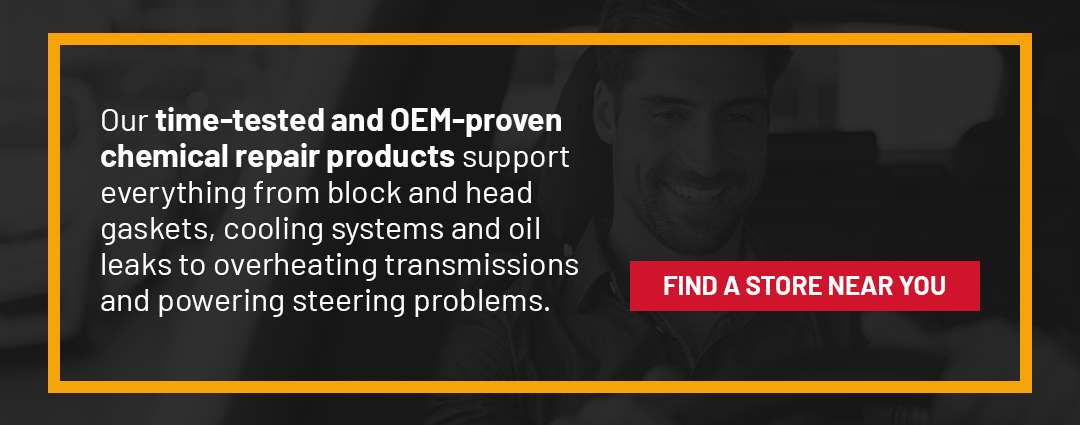Drivers are all too familiar with the fuel light indicator popping up on their dashboard — with some of us waiting until the last second to hit the gas station (we have people like this in the office, but we won’t name anyone). Low fuel is one signal we know not to ignore, but many people choose to disregard other imperative warnings. Several major caution lights require immediate attention while others give you insight — and it’s vital to know the difference. We talk to people all the time on our tech lines about this stuff, so we decided to capture some info into a blog post. Here goes.
When you dismiss warnings, it can be detrimental to the operation of the car, especially over time. To preserve your safety and keep your car in good operating condition, never overlook your vehicle’s caution signs. If you avoid maintenance and repairs, it often results in substantial replacements that you could have fixed on the spot with minimal effort.
Check out our guide to car warning lights and see how Bar’s Leaks can provide fast solutions and repairs.
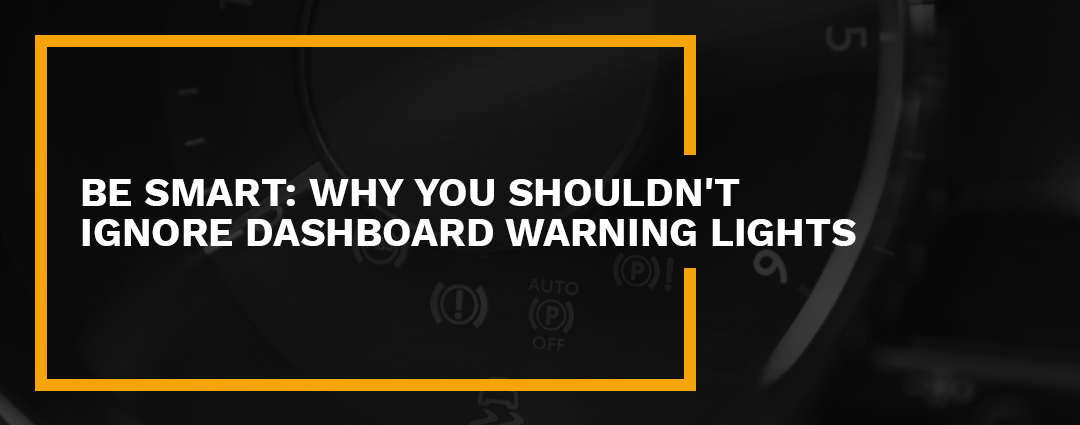
What Do Car Dashboard Lights Mean?
While it’s true that you don’t need to be a professional to repair and maintain your vehicle, it never hurts to know as much as possible when it comes to seeing a light on the dashboard of a car.
According to HPI, a British vehicle data company, about 96% of people don’t know what the brake warning light looks like, and drivers from the age of 18 to 24 take an average of 10 days to take their vehicle to a mechanic. The survey also found that drivers believe tire pressure, coolant, battery and airbag warning lights aren’t urgent, with fewer than 10% of survey respondents calling these lights important.
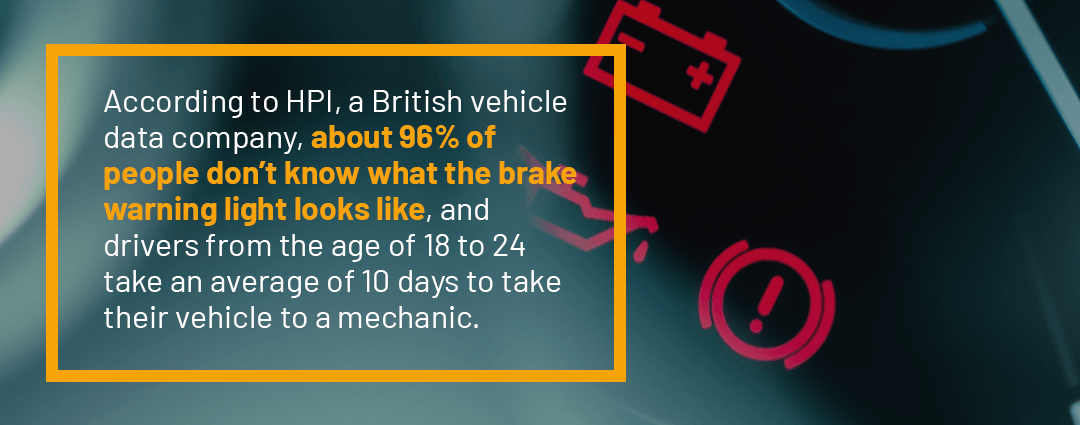
Modern automobiles are like massive computers with a high level of sensors and monitoring. Some of these sensor readings are displayed all the time , such as your RPMs and MPH. But your dashboard can also let you know about the performance of your car without having to look under the hood.
Indicator lights warn you when a problem arises. Every vehicle has advanced technology to monitor the performance of a car, truck or SUV. It can track various components of an automobile, anywhere from the tires and emergency brakes to engine components and fluid levels.
If the car is from 1996 or newer, it has an On-Board Diagnostic II system. Sensors within the engine scan a variety of car operations and deliver messages to the vehicle’s computer. An error code for any malfunctioning engine part shows as a check engine light. The internal system picks up on problems and translates them through lights so that you can make quick fixes. Each light reports a different concern, whether it be in the engine, tires or emergency brake.
Preventative and routine maintenance and repairs are critical aspects of retaining and extending the life of your vehicle, helping to avoid dashboard warning lights. But even when you work hard at keeping your car operating at peak levels, issues can arise.
When you see warning lights, you know it’s a sign of your vehicle’s health. The best thing you can do is tackle the problem straight away to save yourself from more severe repairs down the road. In some cases, the warning lights can be faulty, meaning they can be on all the time or never illuminate. Neither one is a good sign because the system can’t warn you when necessary.
It’s best not to wait until you break down to make the appropriate repair. It can be the difference between being towed and applying a quick Bar’s Leaks solution.
Standard Warning Lights You Should Know
A warning light in a car can illustrate a variety of problems. When you know what each indicator means, you can avoid breaking down while also saving time and money. Nothing’s worse than dismissing a faulty auto part then having to dedicate more time and money in the future. Take a look at the top 10 warning lights you should be aware of.
1. Engine
The check engine light is one of the most common cautions aside from the typical fuel light. While some dashboard notices relate to a single problem, the engine indicator can be a sign of several issues. An engine light can be the result of anything from faulty spark plugs and wires, bad oxygen sensors and a loose gas cap to a malfunctioning mass airflow sensor, worn oxygen sensor or catalytic converter problem.
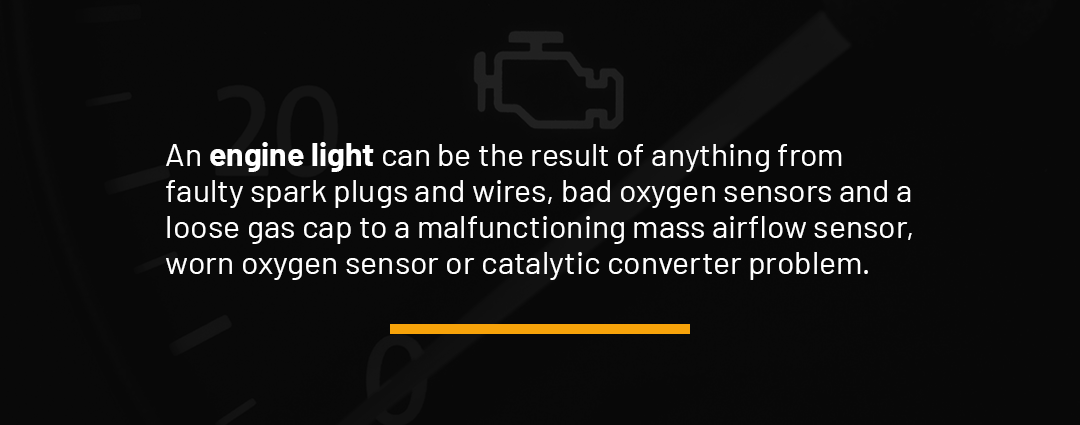
The warning signifies that a critical engine component is failing or already damaged. Depending on the severity of the problem, the light can be red or orange. If it’s a steady illumination, it means the issue isn’t critical, but you should check the engine as soon as possible. If the check engine light is flashing, then there is a severe issue that may require immediate expert assistance.
Your best bet is to pull over right away and shut off the ignition. Wait until the engine cools down to open the hood and make an inspection. Check each component for damage, corrosion and looseness. According to AAA, if you ignore an engine warning, you can destroy the engine and possibly ignite a fire, resulting in repairs that could exceed $1,000.
2. Brake
The brake light is a critical safety feature of any automobile that can state several different problems. The first potential problem is that the emergency brake is still engaged as you’re attempting to drive forward or backward. Check to make sure it’s released all the way, whether it’s a hand-held release or a foot pedal. The brake light can also represent low brake fluid.
The more serious reason you may see the brake light on is if the car’s brake pads are worn. When the brake pads erode, the brake sensors become exposed and new pads should be installed immediately.
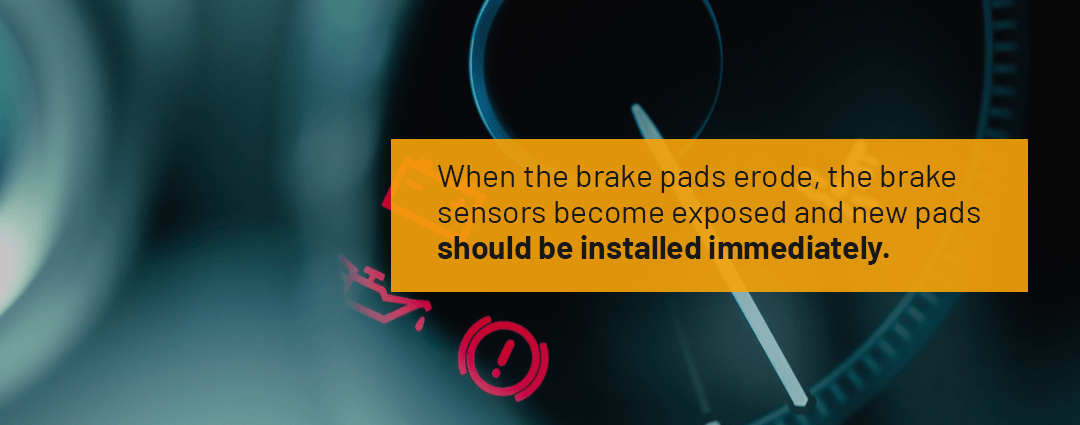
A final cause can relate to the automatic braking system (ABS). If the ABS is the problem, then you have a serious failure on your hands that necessitates fast attention. It controls the stopping of a vehicle when you halt abruptly or brake in slippery conditions. If the ABS light is on without the conventional brake system warning light, it means the standard system is still working.
If both the brake system and ABS indications are on, make sure to pull over right away. Your entire brake system is at risk of failing.
3. Coolant Temperature
When you see the coolant temperature light, it means that the car’s temperature is at an unsafe and extreme level. If you’re driving, turn off the car right away and allow it to cool. Inspect the coolant levels. If it’s low, top it up to the correct line. If you recently filled the coolant, there might be a leak causing the low levels.
The temperature warning light also means you should check the radiator cap and fan to ensure proper functioning. Coolant is an important feature to monitor during warm and hot weather because it maintains the engine’s temperature. Overheating can cause smoke to come from the engine. In the most extreme temperatures, if you fail to turn off the engine, individual parts can become welded together.
4. Oil Pressure
The oil pressure warning light tells you there is low oil pressure, low oil levels or if the oil is too hot. Oil is a critical part of lubricating the engine’s different elements for a smooth operation. Maintaining the oil components, like the flushes and filters, and refilling when necessary, can help you avoid problems.
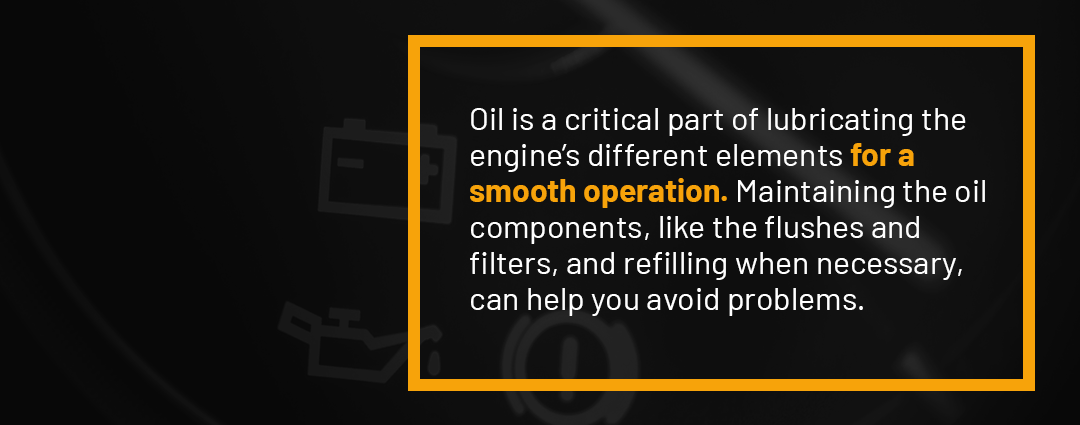
Pull the car over when the warning light appears and look at the oil levels. Fill up the oil until you reach the appropriate mark on the dipstick. Operating a vehicle on low oil can result in expensive damage to the engine and cause it to stop at random. If the oil is full, but the light remains on, you may have a more critical situation.
5. Battery or Charger
A battery warning light can often illuminate when you turn the car on — but it usually goes away after a few seconds. If it’s still present, the battery light can designate a problem with the vehicle’s electrical system, causing the engine not to receive proper power. When the battery charging levels are low, it can specify deteriorating battery terminals, bad alternators, faulty cables or a defective drive belt, meaning the battery needs replacing.
When the light appears, drive the car to a safe location, such as back home or the closest auto shop. You don’t want to pull to the side of the road because a battery with no charge can cause your car to stall. Turning off the vehicle when you see a battery warning light could cause it not to restart.
Auto batteries can corrode, drain and malfunction in varying temperatures. It’s essential to inspect the component during maintenance checks to ensure it functions well and is reliable. Charge or replace your battery as appropriate.
6. Airbag
The airbag warning light is an indicator that many people may not even recognize. Airbags are one of the many critical components that keep you safe in the case of an accident. The light indicates a fault in one or more of the bags. It can mean the airbags won’t deploy properly or won’t engage at the correct time. Check the airbags to ensure they work as intended. If the dashboard light appears, a faulty clock spring may be the culprit.
7. Transmission Temperature
Transmission temperature is similar to coolant in how extreme temperatures can affect an engine. The warning light indicates the transmission temperature has reached dangerous overheating. Your first step is to allow the car to cool down. Then, examine the coolant and transmission levels. Fill the liquid to the recommended line and check for radiator and hose leaks as well.
8.Tire Pressure
Your car’s computer system can understand the operation of an entire vehicle, even outside the engine. For example, the tire pressure monitoring system can determine whether the tires have low pressure. Low pressure can occur from running over a sharp object, extreme wear on the rubber or cold weather.
It’s critical to maintain the proper amount of pressure in all four tires because they are the point of contact between the car and the road. When problems arise with the tire pressure, it can form unstable contact with the ground. In the worst case, low tire pressure can cause accidents.
If the warning appears while you’re driving, hold the steering wheel tight to prepare for any possible blowouts and pull to the side of the road as soon as possible. Check your vehicle’s owner manual and inflate the tires to the appropriate PSI.
9. Power Steering
If the power steering system crashes in your car, it can be challenging to steer and turn. You may not even be able to move the steering wheel at low speeds, which can be dangerous when changing lanes and getting off the road. When the light appears, make a safe exit and check the system for errors. A power steering leak solution can help you make a fast fix.
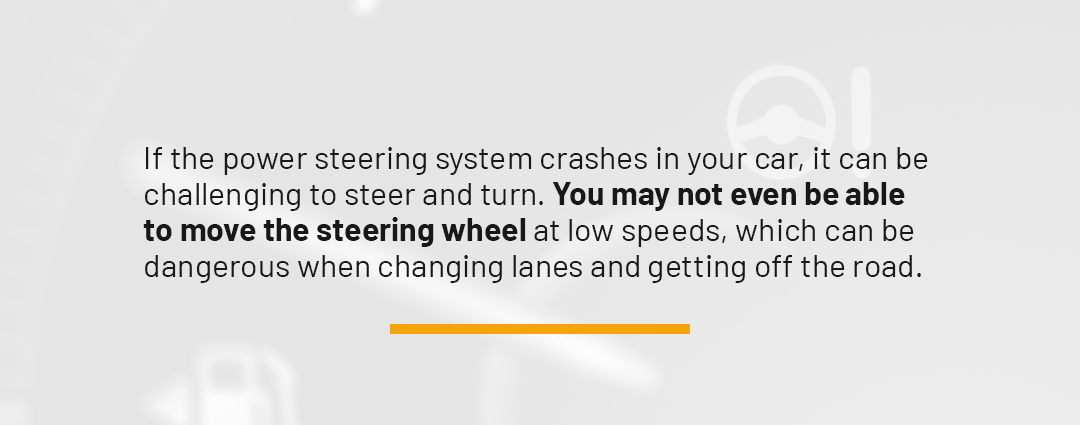
10. Fuel
We are all guilty of leaving the gas light on for too long, but the fuel warning light is still a crucial warning sign to attend. When low fuel levels arise, it can leave you stranded. The best thing you can do it keep it topped-up rather than waiting for the light.
Common problems associated with warning lights can either be minor or significant fixes. Knowing what various dashboard indicators mean and how you can conduct repairs will help you remain safe. You will keep your engine and car components in good standing and save yourself money when you act swiftly.
Be Aware of Other Warning Lights
The top 10 warning lights you should understand are by no means the only ones on your dashboard. Others can tell you when a door isn’t shut or about the conditions of the road. It’s vital to learn about several other indicators as well, such as:
- Engine start
- Fog lamp
- Glow plug
- High beam lights
- Seatbelt reminder
- Service notice
- Traction control
- Traction control malfunction
- Washer fluid levels
Not all dashboard lights specify maintenance and repairs, but they help you understand how your vehicle is operating. Make sure to look through your car’s manual to understand each indicator.
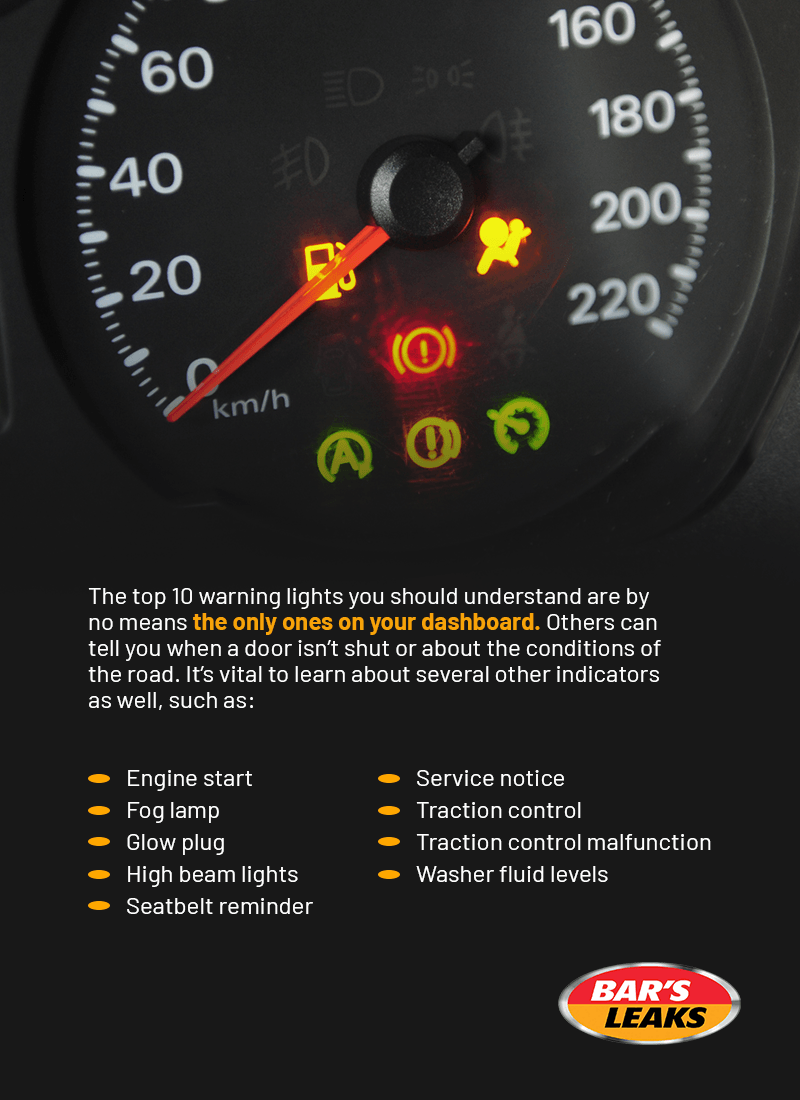
How to Fix Common Issues Related to Dashboard Warning Lights
The first step is to diagnose which light appears on your dashboard and the severity of the warning. Once you know what the symbol indicates, you can move forward with fixes and repairs.
You can also use modern devices and tools to see what’s going on internally by scanning your automobile’s computer system. The scan uses sensor data, computer codes, internal information and freeze frame data to give you an explanation of the lights. Pinpoint testing is available to make sure there are no other issues.
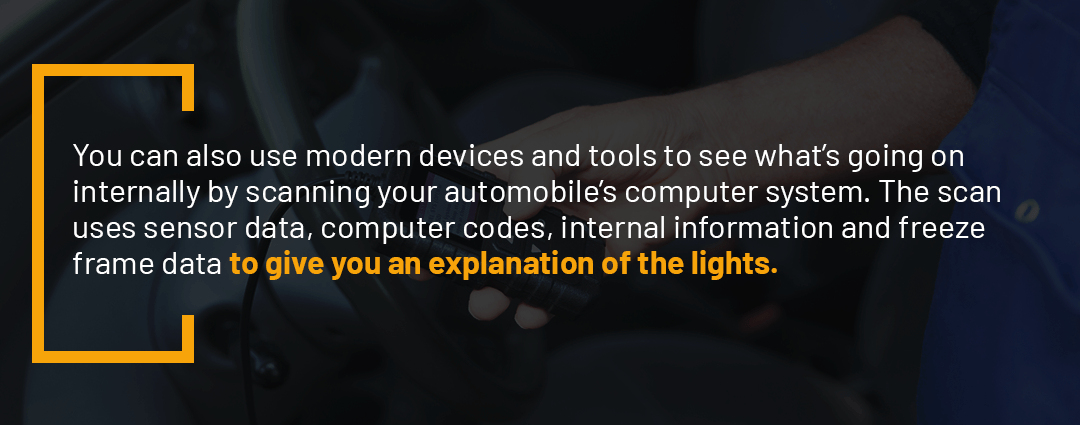
In the case of a check engine light, read the error code from the computer system by using a diagnostic tool to show you which issue is occurring. Try to find out if it’s a minor concern you can fix yourself before taking your car to a repair shop. You wouldn’t want to drive to a shop only to find you just needed to put oil in the engine. If there is a catastrophic problem, then you should take your vehicle to a repair shop.
Some lights may require a quick and simple solution you conduct on the spot as opposed to repairs such as:
- Block and head gasket: If your car calls for a head gasket fix, sealant or blown gasket repair, Bar’s Leaks is the best solution when the warning light appears.
- Cooling system: Because the cooling system is what controls the engine temperature and keeps it from overheating, it’s imperative to have one of our eight cooling system repairs on hand.
- Engine: Our engine seal and leak repairs are a fast way to fix the check engine dashboard light.
- Gear oil: Oil is an essential lubricant to keep pieces of the engine working smoothly. If your engine begins seeping, rely on our gear oil solution to seal leaks.
- Hydraulics: When you start to experience hydraulic failures, Bar’s Leaks has hydraulic formulas to keep you on the move.
- Power steering: Choose from our four power steering chemical repairs to gain control over your steering before anything serious happens.
- Transmission: If the transmission temperature is rocketing, causing the engine to overheat, check out our transmission products that can support your engine.
Necessary fixes and repairs may constitute for top-ups or replacement parts, while others may need rewiring, a software update or repairing broken pieces. But you can often use one of our chemical repairs solutions to stop leaks and boost the performance of your vehicle without having to visit a mechanic. Once you make repairs, reboot the warning light system and be aware of any new lights that appear.
Pack an Emergency Kit for Quick Repairs
When an emergency occurs and one of the warning lights appear, it’s smart to prepare yourself. You can handle simple maintenance and small issues with several items stored in your trunk:
- Air compressor: Inflate your tires that have low pressure or if you have to inflate a spare.
- Oil: Refill your oil when there is a low level. If a leak is present, you can top it up until you reach safety.
- Jumper cables: When the battery dies, jumper cables can get you on the road until your next stop or to where you can receive a new component.
- Bar’s Leaks products: From our cooling system to hydraulic solutions, you should keep our OEM-proven products in your car for fast restoration when a dashboard light appears.
Even when you conduct regular maintenance, issues can still arise when you least expect them. Ready yourself for any dashboard light with the appropriate solutions.
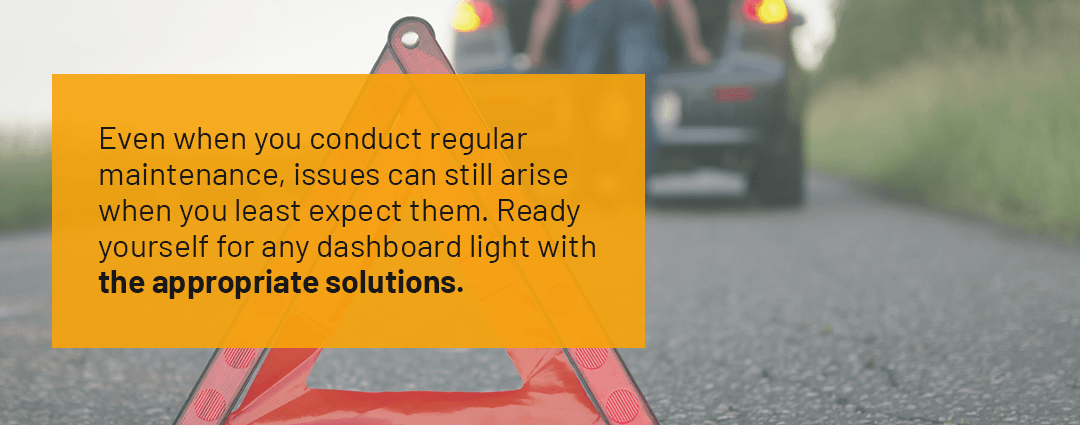
Trust the Experts When Dashboard Lights Appear
Bar’s Leaks has almost 70 years of experience, allowing us to uphold a long-standing reputation in the industry. Our time-tested and OEM-proven chemical repair products support everything from block and head gaskets, cooling systems and oil leaks to overheating transmissions and powering steering problems. You don’t have to be an expert in applying our solutions because we can easily make you a three-minute mechanic with our safe and effective treatments.
Learn more about our products or search for a location near you to find the solution that best fits your needs. Bar’s Leaks has a team of top-tier chemical engineering professionals who educate themselves on modern auto developments to craft products that evolve with the market. You can also contact us to communicate with a representative.
